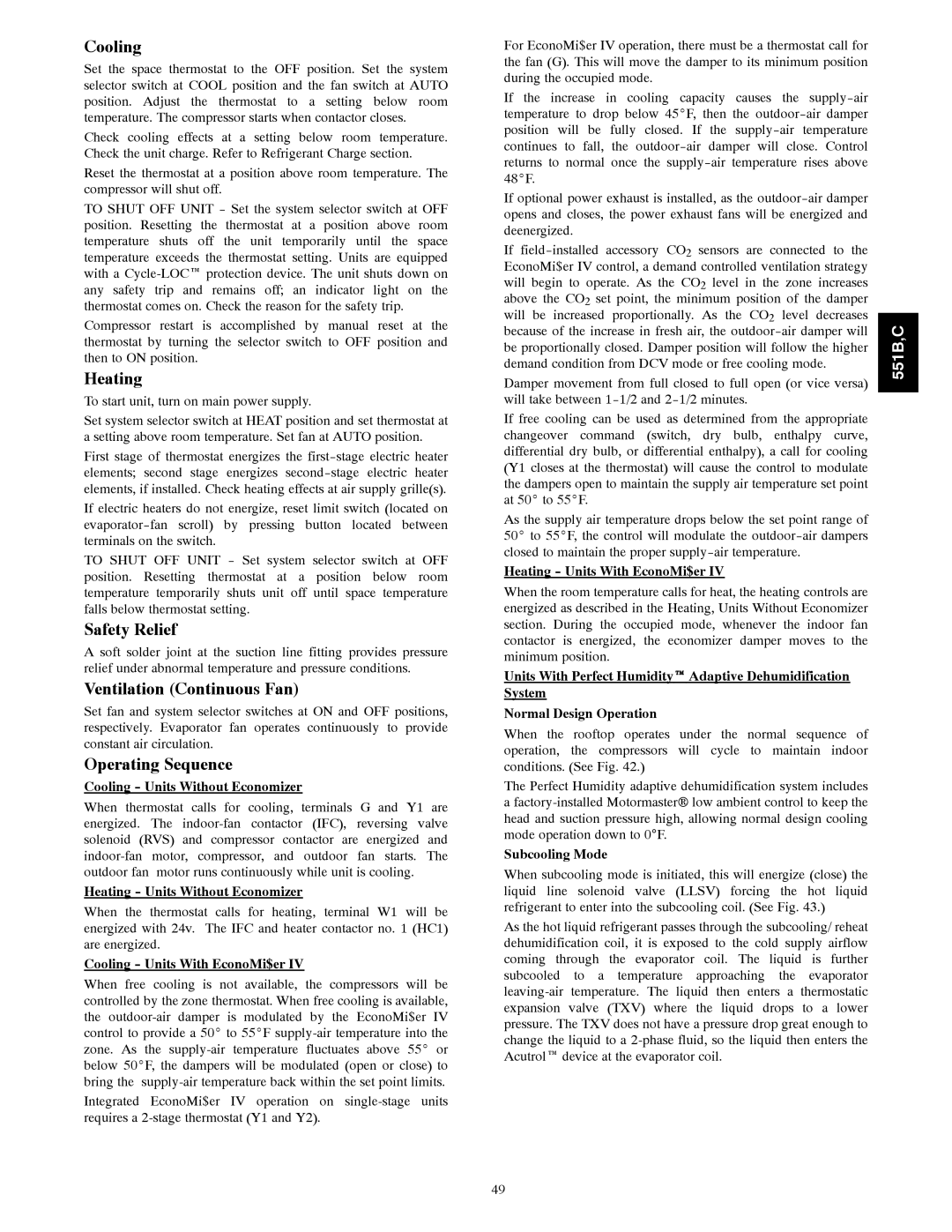Cooling
Set the space thermostat to the OFF position. Set the system selector switch at COOL position and the fan switch at AUTO position. Adjust the thermostat to a setting below room temperature. The compressor starts when contactor closes.
Check cooling effects at a setting below room temperature. Check the unit charge. Refer to Refrigerant Charge section.
Reset the thermostat at a position above room temperature. The compressor will shut off.
TO SHUT OFF UNIT - Set the system selector switch at OFF position. Resetting the thermostat at a position above room temperature shuts off the unit temporarily until the space temperature exceeds the thermostat setting. Units are equipped with a Cycle-LOC™protection device. The unit shuts down on any safety trip and remains off; an indicator light on the thermostat comes on. Check the reason for the safety trip.
Compressor restart is accomplished by manual reset at the thermostat by turning the selector switch to OFF position and then to ON position.
Heating
To start unit, turn on main power supply.
Set system selector switch at HEAT position and set thermostat at a setting above room temperature. Set fan at AUTO position.
First stage of thermostat energizes the first-stage electric heater elements; second stage energizes second-stage electric heater elements, if installed. Check heating effects at air supply grille(s).
If electric heaters do not energize, reset limit switch (located on evaporator-fan scroll) by pressing button located between terminals on the switch.
TO SHUT OFF UNIT - Set system selector switch at OFF position. Resetting thermostat at a position below room temperature temporarily shuts unit off until space temperature falls below thermostat setting.
Safety Relief
A soft solder joint at the suction line fitting provides pressure relief under abnormal temperature and pressure conditions.
Ventilation (Continuous Fan)
Set fan and system selector switches at ON and OFF positions, respectively. Evaporator fan operates continuously to provide constant air circulation.
Operating Sequence
Cooling - Units Without Economizer
When thermostat calls for cooling, terminals G and Y1 are energized. The indoor-fan contactor (IFC), reversing valve solenoid (RVS) and compressor contactor are energized and indoor-fan motor, compressor, and outdoor fan starts. The outdoor fan motor runs continuously while unit is cooling.
Heating - Units Without Economizer
When the thermostat calls for heating, terminal W1 will be energized with 24v. The IFC and heater contactor no. 1 (HC1) are energized.
Cooling - Units With EconoMi$er IV
When free cooling is not available, the compressors will be controlled by the zone thermostat. When free cooling is available, the outdoor-air damper is modulated by the EconoMi$er IV control to provide a 50_ to 55_F supply-air temperature into the zone. As the supply-air temperature fluctuates above 55_ or below 50_F, the dampers will be modulated (open or close) to bring the supply-air temperature back within the set point limits.
Integrated EconoMi$er IV operation on single-stage units requires a 2-stage thermostat (Y1 and Y2).
For EconoMi$er IV operation, there must be a thermostat call for the fan (G). This will move the damper to its minimum position during the occupied mode.
If the increase in cooling capacity causes the supply-air temperature to drop below 45_F, then the outdoor-air damper position will be fully closed. If the supply-air temperature continues to fall, the outdoor-air damper will close. Control returns to normal once the supply-air temperature rises above 48_F.
If optional power exhaust is installed, as the outdoor-air damper opens and closes, the power exhaust fans will be energized and deenergized.
If field-installed accessory CO2 sensors are connected to the EconoMi$er IV control, a demand controlled ventilation strategy will begin to operate. As the CO2 level in the zone increases above the CO2 set point, the minimum position of the damper will be increased proportionally. As the CO2 level decreases because of the increase in fresh air, the outdoor-air damper will be proportionally closed. Damper position will follow the higher demand condition from DCV mode or free cooling mode.
Damper movement from full closed to full open (or vice versa) will take between 1-1/2 and 2-1/2 minutes.
If free cooling can be used as determined from the appropriate changeover command (switch, dry bulb, enthalpy curve, differential dry bulb, or differential enthalpy), a call for cooling (Y1 closes at the thermostat) will cause the control to modulate the dampers open to maintain the supply air temperature set point at 50_ to 55_F.
As the supply air temperature drops below the set point range of 50_ to 55_F, the control will modulate the outdoor-air dampers closed to maintain the proper supply-air temperature.
Heating - Units With EconoMi$er IV
When the room temperature calls for heat, the heating controls are energized as described in the Heating, Units Without Economizer section. During the occupied mode, whenever the indoor fan contactor is energized, the economizer damper moves to the minimum position.
Units With Perfect Humidity™ Adaptive Dehumidification
System
Normal Design Operation
When the rooftop operates under the normal sequence of operation, the compressors will cycle to maintain indoor conditions. (See Fig. 42.)
The Perfect Humidity adaptive dehumidification system includes a factory-installed Motormaster→ low ambient control to keep the head and suction pressure high, allowing normal design cooling mode operation down to 0°F.
Subcooling Mode
When subcooling mode is initiated, this will energize (close) the liquid line solenoid valve (LLSV) forcing the hot liquid refrigerant to enter into the subcooling coil. (See Fig. 43.)
As the hot liquid refrigerant passes through the subcooling/ reheat dehumidification coil, it is exposed to the cold supply airflow coming through the evaporator coil. The liquid is further subcooled to a temperature approaching the evaporator leaving-air temperature. The liquid then enters a thermostatic expansion valve (TXV) where the liquid drops to a lower pressure. The TXV does not have a pressure drop great enough to change the liquid to a 2-phase fluid, so the liquid then enters the Acutrol™ device at the evaporator coil.
